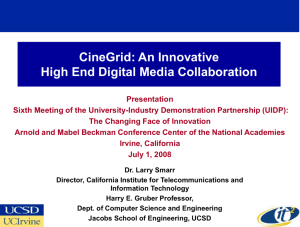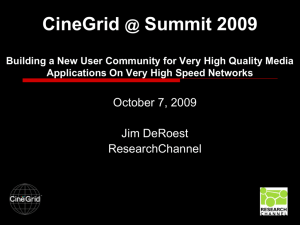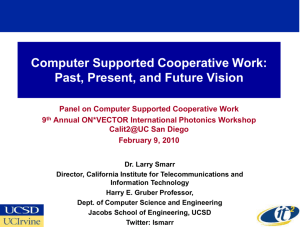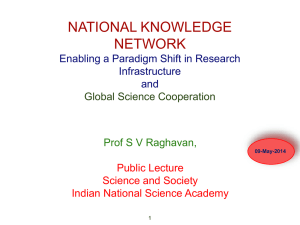on CineGrid - California Institute for Telecommunications and
advertisement
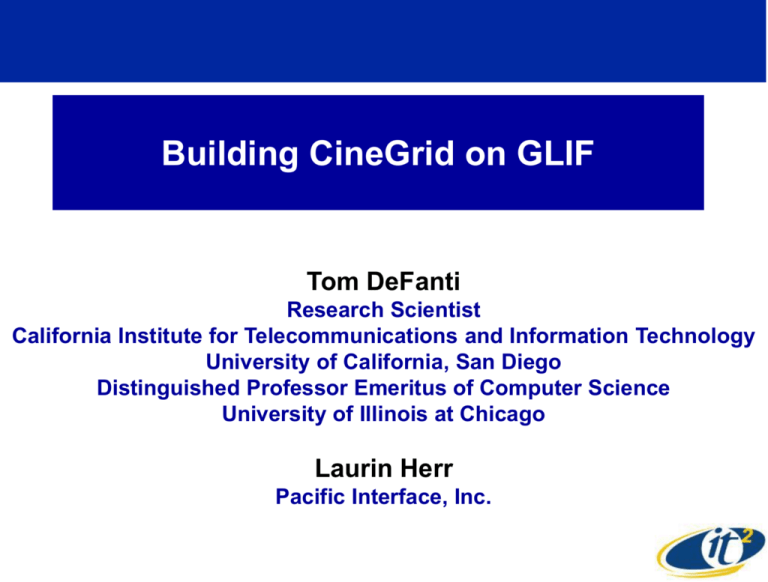
Building CineGrid on GLIF Tom DeFanti Research Scientist California Institute for Telecommunications and Information Technology University of California, San Diego Distinguished Professor Emeritus of Computer Science University of Illinois at Chicago Laurin Herr Pacific Interface, Inc. Digital Movies and Beyond 10 - 100’s Gbps 1 - 24 Gbps 500 Mbps - 15.2 Gbps 250 Mbps - 7.6 Gbps 200 Mbps - 3 Gbps 10s to 100’s of Megapixels 8K x 60 4K2 x 24/30 Tiled Displays 8K (projector) Stereo 4K 4K x 24 2K2 x 24 2K x 24 Digital Cinema HD2 x 30 Stereo HD 100 Mbps - 1.5 Gbps HD x 24 - 60 25 Mbps HDV x 24 - 60 Source: Laurin Herr HDTV Consumer HD Economic Impact of Cinema in California Major Employment from Movie Industry in California by County In 2005, movie production provided employment for over 245,000 Californians, with an associated payroll of more than $17 billion A 2-hour movie digitally scanned and compressed at 500Mb/s takes 450 GBytes Hollywood alone makes 250 movies a year http://www.google.com/maps?q=http://research.calit2.net/a2i/ca.kmz Source: Laurin Herr and Jerry Sheehan CiscoWave: New Capacity for CineGrid Members PacificWave 1000 Denny Way (Westin Bldg.) Seattle StarLight Northwestern Univ Chicago Level3 1360 Kifer Rd. Sunnyvale Equinix 818 W. 7th St. Los Angeles McLean CENIC Wave Calit2 San Diego Cisco has built 10 GigE waves on NLR and installed big 6506 switches for access points in San Diego, Los Angeles, Sunnyvale, Seattle, Chicago and McLean for CineGrid Members Some of these points are also GLIF GOLEs CiscoWave core PoP 10GE waves on NLR and CENIC (LA to SD) Source: John (JJ) Jamison What is CineGrid? CineGrid is a non-profit international membership organization established in 2007 based on collaborative efforts, since iGrid 2002 in Amsterdam, of leaders in the fields of advanced networking and digital media technology from Japan, America, Canada, and Europe. CineGrid is building an interdisciplinary community for the research, development, and demonstration of networked collaborative tools to enable the production, use, and exchange of very high-quality digital media over photonic networks. CineGrid is built on GLIF links by GLIF members. CineGrid organizes major demonstrations with many GLIF users. Historic Convergence Motivates CineGrid • State of the art of visualization is always driven by three communities – Entertainment, media, art and culture – Science, medicine, education and research – Military, intelligence, security and police • All three communities are converting to digital media with converging requirements – – – – – Fast networking with similar profiles Access shared instruments, specialized computers and massive storage Collaboration tools for distributed, remote teams Robust security for their intellectual property Upgraded systems to allow higher visual quality, greater speed, more distributed applications – A next generation of trained professionals CineGrid Founding Members • • • • • • • • • • • • • Keio University DMC Lucasfilm Ltd. NTT Network Innovation Laboratories Pacific Interface Inc. Ryerson University/Rogers Communications Centre San Francisco State University/INGI Sony Electronics America University of Amsterdam University of California San Diego/Calit2/CRCA University of Illinois Chicago/EVL University of Illinois at Urbana-Champaign/NCSA University of Southern California/School of Cinematic Arts University of Washington/Research Channel The Founding Members of CineGrid are an extraordinary mix of media arts schools, research universities, and scientific laboratories connected by 1GE and 10GE networks used for research and education CineGrid Institutional Members • • • • • • • • • • California Academy of Sciences Dark Strand JVC America Louisiana State University CCT Nortel Networks Renaissance Computing Institute (RENCI) Sharp Labs USA Sharp Corporation Tohoku University/Kawamata Laboratory Waag Society CineGrid members operate their own digital media facilities and cyberinfrastructure for digital cinema and HDTV production, postproduction, distribution and exhibition distributed on a global scale, as well as for telepresence, distance learning and scientific visualization. CineGrid Network / Exchange Members • • • • • • • • • • • • • CANARIE CENIC CESNET Cisco Systems CzechLight Japan Gigabit Network 2 National LambdaRail NetherLight PacificWave Pacific North West GigaPOP StarLight SURFnet WIDE CineGrid Network/Exchange Members are GLIF Members too CineGrid Members’ Research • Live performance streaming/video conferencing in 4K and HD with multichannel sound, point-to-point, one-to-many, and many-to-one • • Remote recording of uncompressed 4K camera output in real-time Stereoscopic motion pictures - acquisition, computer generation and display • • Networked multi-channel audio solutions with low latency, accurate sync Remote collaboration workflows and interactive creative tools • • Use of dynamic optical networks Collaboration on tiled displays to 100s of megapixels • • • Digital archiving, long-term preservation, and secure distribution Digital media format conversion, compression and enhancement Digital film restoration using distributed cluster computing resources • Training and methodologies for next generation media professionals Digital Cinema at Calit2 200 seats 1GE to every seat 4K 10000-lumen Sony SXRD 10.2 sound 10GE networking to the projector servers: NTT JPEG2000 Zaxel Zaxstar Dell/Nvidia graphics CineGrid Node at Keio University/DMC, Tokyo Olympus 4K Cameras Sony 4K Projectors Imagica 4K Film Scanner SXRD-105 4K Projector NTT JPEG2000 Codec Presentation in 4K • Sony’s SXRD 4K projector (5000 or 10000 lumens) – R for Digital Cinema HD-SDI inputs, S for DVI inputs • JVC’s 4K projector (3500 lumens) – Good for rear projection--see it at SC07 • Chimei’s Quad-HD LCD panels – Toshiba, Astro Design, Barco(?),others • Sharp’s DCI 4K LCD displays – DCI Cinema Specification (10-bit color, etc.) • OptIPortal Tiled-display for more than 4K Source: Dr. Ohta, Keio University Shooting 4K: Digital Motion Picture Cameras • Olympus OctaVision (Quad-HD: 3840 x 2160) – Developed 5 years ago – Real-time transmission of quad-HD • Dalsa Origin II – Cinema lens is available – De-Bayering is necessary • RED QuickTimeý Dz TIF F Åià• èkǻǵÅj êLí£Év ÉçÉOÉâÉÄ Ç™Ç±ÇÃÉsÉNÉ`ÉÉǾå©ÇÈǞǽDžÇÕïKóv Ç­Ç• ÅB Coming: Sony 4K Camera Source: Dr. Ohta, Keio University Live 4K Video via JPEG2000 (Sender) 4K motion picture camera 4K JPEG2000 Encoder 4 x HD-SDI HD-SDI SW 1-10 Gb/s Only way to do this today ADAT (to HDSP 9652) JPEG2000 Board Source: Dr. Ohta, Keio University Live 4K Video via JPEG2000 (Receiver) 4K JPEG2000 Decoder 4K Auditorium 1-10 Gb/s 4K Projector ADAT from HDSP 9652 JPEG2000 Board Source: Dr. Ohta, Keio University Everyday 4K Pre-encoded File Streaming Streaming Server 4K JPEG2000 Decoder 1Gb/s E ADAT form Encoded File WAV File HDSP 9652 Source: Dr. Ohta, Keio University Shooting Scene in Milan Production Workflow Recording (Olympus OctaVision Case) Optical Fiber (up to 300 meters) HD-SDI Duomo CSC Rec. 709 D65 G2.2 Rec. 709 D65 G2.2 Rec. 709 D65 G2.2 17” LCD HD CRT HD CRT WFM WFM Converter Olympus Octavision Camera Olympus Recorder 3840x2160 24Psf 10bit lin 3840x2160 29.97 Psf 10bit lin 4K HDD RAID5 Recorder Portable RAID5 4K HDD Recorder Station 3840x2160 24Psf 10bit UDR File naming & Numbering Back Up Source: Dr. Ohta, Keio University BNC carries HD-SDI 10-bit 4:2:2 single-link SMPTE 292M Optical fiber carries: 4 HD-SDI GbE Post Production Workflow Example HDSDI Screening Milano XSAN 16bi t Tiff 3840x2160 24Psf 16bit Tiff Rome Rec. 709 D65 G2.2 Rec. 709 D65 G2.6 HD CRT Screen (SXRD) DCD M DCP DSM Quantel iQ (Pablo) 4096x2160 24Psf 16bit Tiff 4096x2160 24Psf 10bit DPX lin Doremi Encoder 4096x2160 24Psf 12bit jpeg2000 lin Import Selected images Offline & Online Editing Digital Color Grading Final Cut Pro Finishing (Titling etc.) 4K Rendering Resize 4K to 1280x720 Offline Editing (rough) Exchange Format ? Select and Delete Images Source: Dr. Ohta, Keio University DCI Compliant Server 4K Pure Cinema Joint Field Trial 2005 WB-NTT-TOHO via CineGrid Japan NTT GemNet2 1 Gbps Tokyo US Seattle CineGrid 1 Gbps Osaka Key center Yokosuka Distribution center1 Distribution center 2 (NTT) (NTT West) Key management NTT’s Fiber network 1 Gbps Theater C (Toho) Takatsuki Los Angeles NTT’s Fiber network 1 Gbps 1 Gbps Theater B Theater A (Toho) (Toho) Roppongi GDMX* Dubbing, Subtitling Daiba (WBEI) Compression, Encryption, File wrapping Color adjust, Quality control Studio (WBEI) Burbank * Global Digital Media Xchange CineGrid@AES October 2006 LDAC Premiere Theater Keio DMC Tokyo DVTS Sony DV Sony 4K Yamaha Mixers Olympus 4K Camera Sync NTT JPEG2000 CODEC and Server Audio CineGrid California Networks CineGrid International Networks Sync NTT JPEG2000 Servers ProTools Audio Server UCSD San Diego USC LA CineGrid @ AES 2006 Keio Wagner Society String Ensemble Holland Fest (6/20-22/07) on CineGrid • “ERA LA NOTTE” Star soprano Anna Maria Antonacci sang solo madrigals from the Italian baroque in the setting of a theatrical concert (http://www.hollandfestival.nl/#festival/voorstelling/9043 ) • 4K transmission – JPEG2000 Compressed (500Mb/s) via IRNC/C(ON)2/CAVEwave to Calit2 on Wednesday – Uncompressed via IRNC/JGN2 to Keio on Friday (8bGb/s) • DVCPRO-HD transmission – Compressed (135MB/s) via IRNC/C(ON)2/CAVEwave to Calit2 on Thursday – Replicated and sent to USC, UW, UIC, Ryerson, (Stockholm), Barcelona, (Prague) as 135Mb/s streams, decoded by PCs • All done with vlans set up in a week or so QuickTime™ and a TIFF (Uncompressed) decompressor are needed to see this picture. Swimming Fiber the Last 500m to the Muziekgebouw Photo: Ronald van der Pol COLOR CORRECTION SETUP – GLIF Demo HD-SDI 2x GE starlight SONY SXRD projector PC with iHDTV 10 GE Baselight output GE HD-SDI Qvidium gateway Pow er Baselight Call IR LAN i-Link GE GE AJA HD-SDI DVCPRO HD Camera Videoconf input HD-SDI e300 GE 10 GE PC with iHDTV Remote baselight console 2x GE C7604 Videoconference output GE i-Link Pow er Call IR LAN GE Qvidium gateway DVCPRO HD Camera Videoconf input PC with Qvidium SW Videoconference output PC with Qvidium SW Summary: CineGrid on GLIF • A new goal for GOLEs: global access to cinema production & post production – Geographic location need no longer be a barrier to your customers creating with the highest media production quality – You can bring your local talent and facilities to distant places – You can show support for your projects nationally and internationally – You will point to increased revenue and employment growth in your media industries working with world-wide collaborators, as well as observable bandwidth utilization of GLIF-style networks Thank You Very Much! • Our planning, research, and education efforts are made possible, in major part, by funding from: – US National Science Foundation (NSF) awards ANI-0225642, EIA0115809, and SCI-0441094 – State of California, Calit2 UCSD Division – State of Illinois I-WIRE Program, and major UIC cost sharing • Argonne National Laboratory and Northwestern University for StarLight networking and management • National Lambda Rail, Pacific Wave and CENIC • NTT Network Innovations Lab • Cisco Systems, Inc. • Pacific Interface, Inc.
